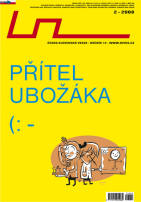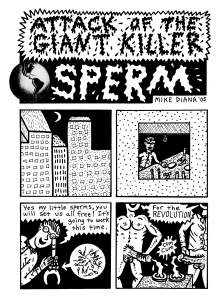| Umělec 2008/2 >> Fullness, plurality, and inner freedom | Просмотр всех номеров | ||||||||||||
|
|||||||||||||
Fullness, plurality, and inner freedomUmělec 2008/201.02.2008 Ivan Mečl | essay | en cs de es |
|||||||||||||
|
The current social situation is by far more complicated and treacherous than the overly sophisticated leftist or right wing regimes of past centuries, where you eventually had the opportunity to tell and verify good apart from evil. In the present times one can stay blind for a lifetime, because the ever-changing and elastic situation fills up every gap of our needs and possibilities. At the same time it keeps spreading the lie that we are able to take control, while still keeping our freedom, our authenticity, inside its frame, but this is only an illusion. Culture, even the one that calls itself independent, becomes only a distributor.
Sometimes only a philosopher, a scientist or a lawyer can address things with their true name. We met with Jiří Přibán in the spring of 2008 after several lectures, that accompanied the release of his new book Pod čarou umění (A Footnote to Art). I read his texts a few years ago, and have always thought that such a person should write about culture. Though at that time he, as a Professor of Law at Cardiff University, was occupying himself with constitutions, law systems, and legality problems, even with the European identity from a legal point of view. These kinds of Přibán’s texts have always built upon great knowledge of philosophy and economic, political, and cultural status. Even these should be on the reading list of a person addressing the functions of culture and art. Without understanding the surrounding world’s principles of function, art history and theory become a tank, which we can only drive around in our backyard. From his published texts I’d recommend studying: How Can We Exist? Forms of Democracy and Identity in the Multicultural Condition, Legal Symbolism: on Law, Time and European Identity, Dissidents of Law, or Liquid Society and Its Law. In professional terms he is thought of as a Eurorealist, a person that doesn’t idealize the object of research, i.e. our society. Though if he is to speak of our society’s culture, it seems as if he’d believe it to be an opportunity for cognition. Inside culture such a belief isn’t maintained by many. It sounds too idealistic. I reckon you’ve noticed that the number of artists has multiplied by hundreds in the past thirty years. It’s easy to notice at collective exhibitions, or the number of authors that take part in exchange programs. Holland and Germany seem to almost mass-produce their artists… Do you think that this is the materialization of the avant-garde’s dream? At the beginning of the last century they said that in the future everyone would be an artist. I do not think that this is the materialization of the avant-garde’s dream. It is moreover a reaction to today’s complex society, no matter if we call it modern, or post-modern, liquid, empty, digital, instant, and so on. The metaphors that modern society makes up to describe or to better understand itself, quickly change and then disappear again. The determining attributes of this society are immense complexity and functionality. But even inside this more and more complicated society - where its individual systems (doesn’t matter if it’s economy, law, or science) cannot be fully understood by nonqualified common sense - every person keeps searching for an opportunity for self-understanding and self-constitution. In other words, every person keeps looking for something that is special, individual, and authentic. Modern society then expects art to offer exactly this very opportunity. Art doesn’t have to be true. But it always has to be real. That is the difference between art and science, for example. The fact that a growing number of people are allowed to create - the massive support of art - might also be an answer to the unemployment question. Sophisticated prevention, how to please the critics, otherwise unneeded by society. Isn’t it a good strategy to prevent the artist/intellectuals, that were the moving force of protests in the sixties, from flooding the streets again? There are enough reasons to do so: wars, poverty, ecology… But it doesn’t seem to strike up enough interest. The potential “naughties” seem to be satiated. We must separate the reason why a person chooses to become an artist, and the art business, i.e. the social support for contemporary art. It is true, that the grants, European funds etc., all of this creates a particular system of social goods redistribution, which of course brings certain control and dependence hazards. Art is then already led into particular canals, information flows, and social expectations beforehand. Is it a good thing, that an intellectual is cultivated through grants? Thanks to this, one shall never become a leading element of social transmutations. The thought that we could understand society as a whole, and thanks to this knowledge we could then commence to change society, is illusory. Every intellectual today knows, that he is moving in some kind of a context, and thus he is not in a prerogatived position of someone, who could describe and understand society in its totality and thus could become, as you call it, a leader of social transmutations. Foucault once referred to Sartre’s philosophy as the last heroic attempt of an intellectual to describe 20th Century society through 19th Century language. Today’s intellectuals are no longer the keepers of general intelligence and culture. Each and every one of them has become a specialist. Today’s ideas aren’t mediated by intellectuals, they are mediated by the internet. But Foucault still thoroughly engaged in the most diverse battles for social and political reforms from the title of his knowledge, no matter if the topics were psychiatric clinics, jails, or marginal minority support. If something from Foucault’s work has still persisted a quarter of a century after his death, then it is above all the ability to lead an active resistance, and to confront the disciplinary techniques of modern society, which are becoming by far more cunning and dangerous. Because even an intellectual can be captive to these techniques. He has to apply for grants, summarize his publishing activities if he works at a university, or he is expected to express his views on public events in banal language through the media. Don’t you think that this multiplication could endanger the exclusivity of an artist? Maybe modernism didn’t thoroughly think through what will actually happen, if this dream really comes true? These are parallel processes. We have more opportunities and more control. The current society provides great opportunities for self-constitution, and not only for artists. But nobody is taking advantage of these opportunities. A person has the potential for all sorts of activities, but a person is the happiest, when he is passive. At the same time the society creates these opportunities in such manner, that it can always have them under control. In sociology taking advantage of such opportunities is called adaptability to external conditions. Freedom is then understood as the ability to adapt to an environment and make use of it for your own good. It has nothing to do with exclusivity. Only in modern times is an artist expected to create something that shall be authentic, original, and exclusive in a certain way, under any conditions. The uniqueness of art resides in such a contradiction of social adaptation. The artistic truth is never absolute, but it always has to be personal and lived through. This expectation is what the avant-garde was basing its protests against social conventions upon. But we live in times where we don’t have to ask what art should protest against at all. What’s worth protesting in an evermore faster changing and unstable society? We have to ask, what opportunities exist for something we call engaged art? Thus today’s art must be analytic, not utopian. And isn’t this just a romantic image of an artist? An artist was never a model of a moral personality. Mostly he was one of the most opportunistic and salable individuals. You’re right. Romanticism and the birth of modern society go hand in hand. Suddenly the artist is the bearer of genius, of collective soul - be it the soul of a certain nation or a soul of the whole world, reflected through art. As if the artist was asking himself questions on behalf of the common mortal. That is of course a very dangerous role. It lures one to think of the artist as of a conscience of mankind, the conscience of a nation, and as a conscience of a prophet. A prophet that tells the common mortal what to do and what not to. Authenticity hides very strong and tempting normative expectations. Is art the last domain, where an author can let himself simplify, abbreviate, without passing off as awkward? On the intellectual field there is an ongoing anxiety from abbreviating. The authors mostly state beforehand that the whole problem is “of course much more complicated”. Only in art it is possible to say: “No, it’s not more complicated, it has been wrong since the beginning.” Well, that’s dead on. Art is exactly a domain where humor, allusions, non-seriousness, and irony reign. You can understand something, which otherwise seems incomprehensible through a fragment, or an apparently marginal remark. Art actually brings us back to reality. But is that a good thing that it has stayed this way only in art? This is for sure the function of art in society. And thanks to this a lot of people today create art, rather than looking at it, listening to it, or reading it. There exists a need to do something, but there is also the need to understand reality, which seemingly stays trapped in the hands of expert knowledge. Self-constitution and self-understanding go hand in hand with the much more common need to understand the surrounding environment and to reorganize it. There is the need to do something and on the other hand there is the contemporary art business that lacks the sex appeal of classic modernism. Today we communicate through self-constitution. Art today has indeed an indirect, but so much more important political function, because through art we can see, that things can always be done differently. There’s always an alternative, while in politics there are often none. While in art you invent, in politics you decide. Political symbolism, no matter if leftist or rightist, is conservative. The national flag, the rose, the bird, or the pair of cherries as a communist party symbol all say: “Follow us, let yourself be led, because otherwise we don’t need you at all!” Keeping these two worlds - art and politics in friction, that is what modern society stands and falls apart on. Not letting any political or any other form of social communication, from media commercials to seemingly exact economic prognosis lure you into total passivity. That is where I see the important function of creating art. Art in today’s society is a specific form of structural irritation. Art has its education system, its market, factories, agencies, stockholders, fairs, domains where profits and employees are being counted. Won’t those who want to take on a fundamental and independent creative approach leave the art field at this time, when art has changed from a small, more or less autonomous domain into an industry? Adorno used to attribute the culture industry with a sign of totality, absurd submission, prefabrication, and passivity. But he underestimated common human creativity. The fact that a person will never let anything be imposed upon himself without rests. Culture isn’t only an industry, although it undoubtedly is crucially influenced by it. So today we can say that culture has primarily become entertainment. When we talk about the culture business, we have to mention the hazard, that art might become just a decoration, an ornament. Then it cannot resonate in public space. It is actually one of the many forms of today’s all-penetrating depoliticisation: “I am representing myself and I do not need to represent what is happening in society.” But art will never be only private. Don’t you think that artists are reacting on current society way too much? Where is the abstraction that culminated Malevič’s work? That wasn’t so much about a relationship with society, it was about abstract and transcendental values. Abstraction was a part of modern thinking. Isn’t today’s artistic reaction to the world too specific? Just like the media and advertising? I saw Emil Nolde’s aquarelle exhibition last year in Bremen, which he created during fascism, when he wasn’t allowed to exhibit publicly. He was travelling around Germany and one of the most admirable reflections of misery in nazi society came only out of his personal need to create - a personal decision, which an artist was forced to make under violent political pressure, ultimately tells so much more about those times and society than any hard political production. But we can only tell in the course of time, comparing present to past. And also based on our current knowledge of that time in history. But doesn’t that also speak of incorrigibility? From this point of view we should already know that fifty years from now we won’t see an exhibition of Saddam in formaldehyde because media images from these times will be more authentic. Naturally there exists the danger that art will become overly contextual. I liked Saddam formaldehyde very much, but it is obvious that without the knowledge of a specific artistic and political context the purpose of such production quickly disappears. It lives in a moment just like twenty-four hour media coverage programs or commercials. But it needs to be said, that the same, maybe even bigger danger looms over conceptual and post conceptual art. Beuys' saying, that everyone is an artist, can be understood as a statement to provoke talents, to let out their creative energy, but naturally not everyone has the talent. So it’s just one big lie. An illusion that could have led to the situation, which we began this interview with: that today there are just too many artists.
01.02.2008
Рекомендуемые статьи
|
|||||||||||||
|
04.02.2020 10:17
Letošní 50. ročník Art Basel přilákal celkem 93 000 návštěvníků a sběratelů z 80 zemí světa. 290 prémiových galerií představilo umělecká díla od počátku 20. století až po současnost. Hlavní sektor přehlídky, tradičně v prvním patře výstavního prostoru, představil 232 předních galerií z celého světa nabízející umění nejvyšší kvality. Veletrh ukázal vzestupný trend prodeje prostřednictvím galerií jak soukromým sbírkám, tak i institucím. Kromě hlavního veletrhu stály za návštěvu i ty přidružené: Volta, Liste a Photo Basel, k tomu doprovodné programy a výstavy v místních institucích, které kvalitou daleko přesahují hranice města tj. Kunsthalle Basel, Kunstmuseum, Tinguely muzeum nebo Fondation Beyeler.
|

































 We Are Rising National Gallery For You! Go to Kyjov by Krásná Lípa no.37.
We Are Rising National Gallery For You! Go to Kyjov by Krásná Lípa no.37.
Комментарии
Статья не была прокомментированаДобавить новый комментарий